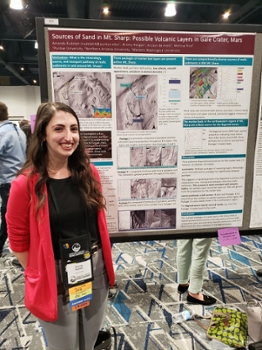EAPS Graduate Student Investigating Gale Crater on Mars
09-04-2019
Writer(s): Logan Judy

Amanda Rudolph didn’t always know she would be a planetary geologist. Despite her current work – researching the geological history of Mars using remote sensing – she took a few years off following high school, then entered Community College. It was there that, in her words, she stumbled into a geology class.
“I fell in love with it,” she said. “One of the first labs was counting craters on the moon. After that I was sold. I transferred to a university, did lots of research, snagged an internship, and just kind of implanted in the field.”
At Western Washington University, she did research with Dr. Melissa Rice, who works in planetary geology. Her internship afterward was at the Lunar and Planetary Institute in Texas, where she worked with Curiosity rover data, preparing her for her current research. She now works with Dr. Briony Horgan of EAPS on Mars mineralogy. Her research is focused specifically on using orbital and rover data to understand the geologic history of Gale Crater region on Mars. She’s been named a recipient of the Indiana Space Grant for this work, provided by the NSF-affiliated Indiana Space Grant Consortium.
Gale Crater was formed when a meteor struck Mars in its early history, 3.5 to 3.8 billion years ago. Gale served as the landing site for the Curiosity Rover because there are signs that water was present in its history. Both clays and sulfate minerals can be found in the region, providing ample material for Rudolph’s mineralogy work.
“I’m using orbital data to make a more finely-tuned geologic map of the materials in the region,” she said. “I’m looking at particular layers in the mound that look strange when we examine their morphology and mineralogy. The Curiosity Rover is going to be coming up on these layers in the coming months, so I’ll be using the rover’s eyes to compare what we see from orbit to what we see on the ground.”
That comparison piece is important, because it has implications that go beyond Mars. We aren’t able to put rovers on all planets we want to study, so understanding how we should interpret orbital data for those places.
“If we’re going to be using orbital satellites to look at other planets, we have to ask, ‘What are we seeing from orbit and how does that compare to the ground?’” she said. “So if we get this orbital data and we see something, and compare it to the rover, and there’s a discrepancy, understanding the difference between orbital and rover data is really important for not just Mars, but other bodies we don’t have rovers on.”
Rudolph anticipates graduating in spring 2023.